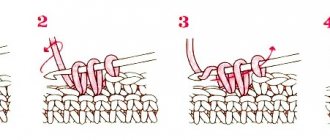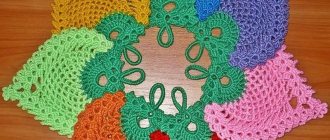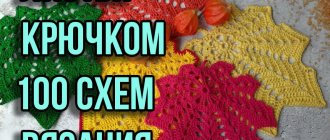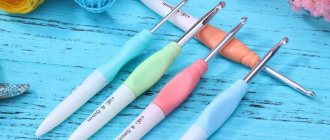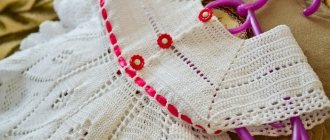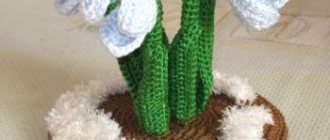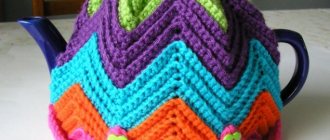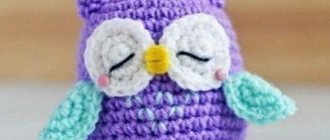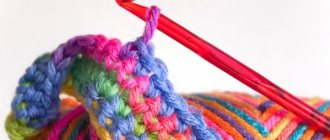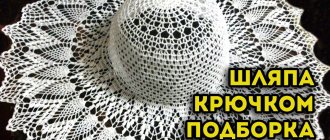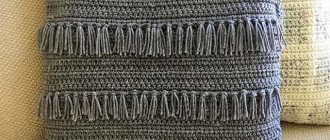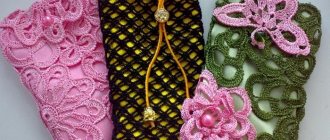Stylish knitted socks are an important part of not only children's, but also adult's wardrobe. Thin fishnet socks complement the look in the summer, while thick wool socks help keep you warm in the cold winter.
At first glance, it seems that connecting them is very simple. But, as a rule, beginning needlewomen think about how to crochet socks after they have acquired minimal knitting experience.
Stylish short socks for teenagers
Teenagers are quite scrupulous in choosing clothes, and it’s not at all easy to please them! The ideal option for a young girl or boy would be short, plain socks. This model is especially popular among young people, as it not only warms the leg, but also allows you to wear your favorite cropped jeans.
Tools and materials needed for foot size 35:
- hook;
- acrylic threads folded in half;
- beacons;
- scissors.
The following abbreviations will be used throughout this work:
- v.p. - air loop;
- n. - loop;
- R. - row.
Crochet socks for beginners with step-by-step description:
Form the first loop.
From it, knit 4 chain stitches.
Connect the resulting chain to the first loop.
Next, start knitting in the round. Knit 2 stitches into each stitch.
To avoid getting confused in circular knitting, place a beacon. Form 3 r.
Now knit every 1 stitch. That is, knit 1 stitch in the first stitch, and 2 stitches in the second.
At this stage, be sure to try the blank on the leg. If the required length is knitted, place a beacon and count the loops.
Be sure to write down the number of stitches. This way, when making a second sock, you can knit an identical pair!
Continue working using the circular knitting method.
When the sock “grows” to the desired length, begin shaping the heel.
Don't forget to write down the number of connected rows! There are 22 of them in this model.
Calculate the number of loops so that the foot can freely “enter” the sock. For convenience, leave the number odd.
Subtract the number of loops from the number of rows, and you will get the number of loops needed to knit a heel. 22-9=13.
In the point where the work stopped, dial 2 vp. Turn the product, knit in the opposite direction.
Having tied the river repeat the steps again.
Don't forget that you only need to knit those loops that were left for the heel!
Having knitted the required number of rows, try on the sock.
Start shaping the heel. Divide the remaining loops by 3. 13:3=4 (+1).
Thus, knit 4 stitches on the sides, and 4+1 on the bottom.
In the next r. form the side and bottom parts. Then insert a connecting stitch into the base loop.
Unfold the fabric, knit the bottom part and connect the work with the next stitch. sidewalls.
Turn over and repeat until you reach the top.
Having made the heel, perform 2 ch. rise and continue knitting in the round.
At 2 and 3 p.m. Make 1 decrease on both sides.
If you want to increase the height, knit a few r. double crochets. First, dial 3 vp.
Then knit a row and join using a connecting loop.
Cut the thread and fasten it.
Use this method to complete the second pair.
To knit not short, but warmer high socks, lengthen the top using a fashionable “scale” pattern.
Crochet socks, models from the site kru4ok.ru
We have some beautiful crochet socks with descriptions. We present them to your attention.
Crochet knitted warm socks. Alexandra's work
Knitted warm socks. I crocheted the socks from individual hexagonal motifs. Yarn - wool, two colors. Hook No. 3.5.
I started knitting socks from the insole. For size 38 I cast on 26 air loops. Knitted according to the pattern. Then I knitted 5 6-gons for each sock, alternating colors in different ways. The scheme is also very simple. Then I sewed the motifs according to the pattern. Where there is a greenish stripe in the diagram, I tied it with double crochets to increase the size. I sewed and sewed the insole with a needle using a hidden seam.
Sock knitting pattern:
Openwork crochet socks, master class!
Crochet openwork booties. At first I knitted these slippers for myself (I found the description on the Internet), I really liked the way they fit my feet. I decided that they would look good on little ones too. I calculated the dimensions for a tiny leg, knitted it - it turned out
Read more…
Crochet socks
Imagine what a pleasure it is to receive such cozy and charmingly flirty crocheted socks as a gift! Striped pattern (width 24 sts): knit in circular rows according to pattern 3. Do 1 time from the 1st to the 3rd row, then repeat the 2nd
Read more…
Crochet striped socks
Sock size 37-38. You will need: 40 g mustard colored acrylic yarn, 30 g each beige and brown yarn. Hook No. 3. TYPES OF LOOPS Chain loop (chain loop): insert a hook into the st, throw a thread over it and pull through
Read more…
Crochet socks - Anastasia's work
Cute socks, I found the pattern in old school collections, size 40, the bottom of the sock is knitted using my grandmother’s usual method. Pattern for the top of the socks: How to crochet socks, see our website: Striped socks Crochet socks
Read more…
Crocheted New Year's socks
Sizes: 35/37 – 38/40 – 42/44 (EU sizes). Foot length: 22 - 25 - 28 cm. You will need: DROPS ESKIMO yarn (100% wool, 50 m = 50 g) 100 g for all sizes red; 50 g for
Read more…
Slippers - socks
Sock sizes: 36/3/ - 38/40 - 42/44. Sock foot length 22 - 25 - 28 cm. Yarn for knitting socks: Eskimo (100% wool, 50g - 50m) 200-200-250 g color 01, natural, and also: Puddel (64% mohair. 20%
Read more…
Socks for a little princess with an elastic band
To make beautiful socks for a newborn baby, you need to prepare in advance:
- hook No. 2.7;
- cotton yarn;
- scissors.
The following types of abbreviations are used in the job description.
Training master class:
At the first stage of learning, tie an elastic band. To form it, first cast on a chain of 8 stitches.
At 1 p.m. starting from 2 sts from the hook, perform in each st st. b/n.
2 rows: aerial pet., st. b/n behind the back wall of the column from the previous row.
For a baby aged 0 to 3 months, knit an elastic band consisting of 24 r.
Connect opposite sides of the elastic band.
At the next stage, start knitting the legs. You should start by tying one of the edges of the front part of the elastic band.
Take a thread of a different color and knit 24 tbsp. b/n. Close the row with a connecting loop and turn out the elastic.
Work 2 ch, and then work a st in each stitch from the previous row. s/n.
Working in stages, knit 3 more rows.
Finish the last row with a thread of a different color and immediately proceed to knitting the heel.
First r. heels: vp, st. b/n – 12 pcs., rotation of the product.
Then, using the same principle, do 3 more p.
5 p.: aerial pet., st. b/n – 4 pcs., decrease from 3 tbsp. b/n, 5 single crochets.
Now fold the heel and darn or crochet along the wrong side so that you get the same piece as in the photo.
At the next stage of MK, form the foot. Take a thread of the main color and secure it to the heel.
6 rub. knit in a circle: 2 chain stitches, st. s/n – 24 pcs., connecting item.
Attach a thread of a contrasting color and begin knitting the toe. 1 r.: v.p., decreases – 12 pcs., connecting st.
2 p.: air loop, decreases - 6 pcs., connecting.
Sew up the hole, cut the thread and hide it.
Unscrew the rubber band. Using the same pattern, knit the second sock for the girl!
LiveInternetLiveInternet
Source: https://www.stranamam.ru/post/8556965/
We crochet warm, flirty socks with a simple jacquard pattern and a voluminous pattern on the cuff . To knit socks you will need 50 grams of white wool blend yarn of medium thickness and 100 grams of light purple yarn, hook No. 3.5. We start knitting a sock with a set of 8 half-columns from a thread ring, then tighten the ring and make a connecting loop into the 1st half-column.
Next, we begin to knit the sock in half-columns, making increases along the sides to the width of the foot, according to pattern No. 1. Having knitted 9-11 rows with increases, we continue knitting in the circle in half-columns. To knit the pattern, introduce a light purple thread and knit with a simple pattern, alternating 2 half-stitches with white thread over dark loops and 2 half-stacks with purple thread over white loops, knitting technique and changing threads
Having knitted a sock 17-18 cm from the start of work, continue knitting with one purple thread for another 5-6 rows, adding 1 additional half-stitch along the sides in each row.
Then start knitting the heel with single crochets in straight and reverse rows according to pattern 2 on the middle part of the sole, moving on to the beginning of knitting with connecting stitches. While knitting the heel, simultaneously attach it to the toe to the middle.
Next, continue knitting the shaft with half-stitches in circular rows.
After knitting 5-6 rows, knit a cuff with a voluminous pattern according to pattern 4, starting with 2 rows of single crochets.
Crocheting openwork socks Openwork socks are comfortable to wear during the hot season. You can learn how to crochet such elegant socks by watching this sock knitting master class. You will need 100 grams of yarn and a hook. The most pleasant yarn to wear in hot weather is cotton, so for knitting socks, choose medium-thick cotton yarn and a No. 2.5 hook.
You need to knit socks in the following sequence: first, the toe of the sock is knitted, then the main part with an openwork pattern to the heel, the hole for the heel is created from an additional set of chain of air loops, along which the openwork pattern of the sock cuff continues to be knitted. Having finished knitting the cuff, attach the thread at the hole for the heel and tie the heel. Crochet sock pattern:
Now let’s learn more about knitting an openwork sock according to the pattern: Knitting a toe. Cast on a chain of 60 chain stitches and close it into a ring with a connecting post. The opening of the starting ring should be equal to the width of the foot at the toes.
Make 3 chain stitches and double crochet the first row. In the second row, start making decreases: 3 up. p. rise, 3 st s/n together (with one top), 24 st s/n, 3 st s/n together, 1 st s/n, 3 st s/n together, 24 st s/n, last 3 st s/n with one top. End each row with a connecting loop in the third lifting loop. Third row with decreases: 3 air. p. rise, 3 st s/n together, 18 st s/n, 3 st s/n together, 1 st s/n, 3 st s/n together, 18 st s/n, last 3 st s/n together . As you noticed, the point on the sides is 3 air. lifting loops and double crochets before and after which decreases are made. In the next rows, make decreases near these points, knitting together not three, but two stitches together, gradually narrowing the toe towards the top. Having knitted 6 rows of the toe, sew the remaining hole at the top or knit a connecting row, inserting the hook behind the half-loops of both sides of the hole.
When finished, cut and fasten the thread.
To knit the main part of the sock, attach the thread to the starting point of the toe. Knit the openwork pattern in the round, ending each row with a connecting stitch in the last lifting loop.
After tying the sock to the heel and finishing the openwork pattern on the odd row, make a hole for the heel. To do this, cast on a chain of 30-37 chain stitches, trying on the instep of the leg, and secure the chain with a connecting post on the other side of the sock.
Next, continue to knit the openwork pattern, first along the main part, then along the cast-on chain.
Having knitted the cuff to a height of 12-14 cm, finish knitting the openwork pattern in an even row with the picot elements in the pattern.
The last step in knitting the sock is to knit the heel on the left hole. To do this, attach a thread to the side part (the junction of the cast-on chain and the main part of the sock) and make 3 air. p. rise for knitting the first row. Knit the first row around the hole with double crochets. From the second row, start making decreases as when knitting a toe from the center of the sides. In the second and third rows, make decreases by knitting 3 double crochets together before and after the side point, the fourth, fifth and sixth two double crochets together.
Having knitted the heel, sew the remaining hole or knit the connecting row. When finished knitting, cut and fasten the thread.
The second sock is knitted exactly the same as the first.
Master class on crocheting the most basic warm and cozy socks https://igmihr.ru/MK/05/5.html
You will need: yarn of any thickness and a suitable hook.
1. According to pattern 1, tie the toe to the widest part of the foot. Then tie the flat part to the lifting wedge, guided by the first table.
2. Guided by the second table, knit the required number of rows for the instep wedge and move the connecting loops to the beginning of knitting the heel.
3. Using pattern 2, knit the heel (each pattern indicates the number of stitches for the heel). 4. Finish knitting the heel by picking up the first half stitches from the instep wedge, and knit one row in a circle with single crochets.
5. Knit 3 rows with half-stitches and work an elastic band from the front and back stitches. s/n according to scheme 3.
Author by Butoni.
So let's get started! Knitting begins with the cuff. We cast on the required number of elastic loops (I have 48) and close them into a ring with a connecting post.
Here's how to cast on stitches to create an elastic edge: Unwind the end of the thread three times longer than the intended length of the cast-on row. Lay the thread on your left hand, as when casting on knitting needles (Fig. 1). On the index finger there is a thread from a ball, and on the thumb there is a free end of the thread. Insert the hook under the thread on your thumb, grab the working thread and pull through the first loop. Release the thread from your thumb and tighten the knot. Pick up the thread again with your thumb (Figure 2). Insert the hook under the thread on your thumb, grab the thread and pull through the loop. Release the thread from your thumb and tighten the knot. There are two loops on the hook. Pick up the working thread and knit these two loops. Pick up the thread again with your thumb and repeat all steps until you have knitted a chain of the required size.
Then we knit the elastic with 1*1 embossed stitches in a circle.
We knit to the desired elastic size (mine is 12 cm, that’s 20 rows).
Then we knit 5 rows with single crochets. also in a circle.
Now let's start shaping the heel. We knit the back straight fabric of the heel. To do this, divide the circle of the loops in half and knit in the forward and reverse directions with single crochets (I have 18 rows).
Now we divide the straight fabric of the heel into three parts (the middle one can be made larger, but the side ones should be the same) and continue to knit in the forward and reverse direction on the middle loops and attach the side parts (for this: we knit a row of middle loops, insert a hook from the front side under the top of the nearest loop of the side part, grab the thread and pull it through the loop of the fabric and the loop on the hook). Thus, the middle part will join the side. This is the heel we got.
Having formed the heel, we continue to knit in a circle with single crochets. To form an instep wedge, we knit two stitches with one common vertex to the right and left of the upper edge of the straight heel fabric. We continue cutting until the original number of stitches (I have 48 stitches, so I got 12 rows with shortening).
We continue to knit in circles without changes to the base of the thumb.
Well, here's the final point! Knitting the toe: Divide the loops into 4 equal parts and knit 2 stitches with one common vertex at the beginning of each quarter. Having finished cutting, break the thread and fasten it on the wrong side! Hooray!!! The sock is ready. Knit the second sock symmetrically to the first!
I used Finnish threads, 100g/260m, warm and soft!
Warm socks - for dad and son https://idi-k-nam.ru/post284220939/?upd You will need (size 45 - foot length 28-29cm): "Children's whim" yarn (60% wool, 40% acrylic, 225 m/50 g), 100 g yellow, 100 g jeans, hook No. 3. ! Knit with thread in two folds! Main part: using denim-colored thread, knit a chain of 3 chains, connecting it into a ring. 1st row: knit 7 tbsp in the center of the ring. b/n. 2nd row: 2 tbsp. b/n in each st. previous row. 3rd row: *1 st b/n, 1 increase (2 st b/n in each st of the previous row)* 4, 6, 8, 10, 12 rows: no increases. Row 5: *2 tbsp. b/n, 1 increase*. Row 7: *3 tbsp. b/n, 1 increase* 9th row: *4 tbsp. b/n, 1 increase* 11th row: *5 tbsp. b/n, 1 increase* 13th row: *6 tbsp. b/n, 1 increase*. (56 stitches) Rows 14-23 – knit straight. 23rd row - unfold the work, knit 30 stitches. b/n. Next, repeat the 23rd row another 28 times. After this, knit 8 rows as follows: knit st b/n, decreasing 2 sts in the middle of each row. Finish knitting. Sew a seam on the heel.
“Tongue”: tie 16 sts in the center of the AC line. b/n with yellow thread, knit 15 cm. In the last 4 rows, make decreases at the beginning and end of the row for rounding.
Upper part: use yellow thread along the ABC line to knit 11 rows of st. b/n. Next, continue knitting st. b/n, without knitting 3 stitches at the end of each row. Knit a total of 4 rows in this way. Next, knit 4 rows, leaving 1 st at the end of each row. Then knit straight stitch. b/n approximately 17 cm. The last row is a “crawfish step”.
Assembly: tie the edges with denim thread in 4 rows of stitches. b/n. “Edges” refers to the front vertical parts of the shoe. Tie a cord from air. p. yellow thread approximately 1.5 m long. Insert the lace using a hook, grabbing the “tongue”, as shown in the photo. Then tie a circle with denim thread and sew it on.
You need to lace up so that the “tongue” does not dangle inside, but is inside the lacing...
https://mom's-hands. рф/forum/viewtopic.php?p=258#p258 Striped socks “Sunny Glade”, crocheted from the toe Crochet for women Sizes: 38/39(40/41)42/43 Who said socks are boring ? Bright stripes will brighten winter evenings with the colors of the sun. You will need: - 75 g of orange yarn (10% merino wool, 95m/25g); - 50 g each of yellow and green yarn (51% wool, 49% polyacrylic, 97.5m/25g); - hook No. 2.5; - 2 buttons. Legend: ch - chain stitch ss - connecting stitch sc - single crochet hdc - half double crochet Basic pattern: knitted with half double crochets, with each circular row starting with 2 chain stitches instead of 1 half double crochet and ending with 1 connecting stitch into the upper air lift loop. From the 2nd circular row, turn the work before each circular row. Striped pattern: 3 rows with the main pattern with orange thread, 1 row with the main pattern with green thread, 1 row with the main pattern with yellow thread, 1 row with the main pattern with green thread, 3 rows with the main pattern with orange thread. Knitting density, main pattern: 23 p. and 18 r. = 10 x 10 cm. How to crochet striped socks from the toe Right sock. Use a yellow thread to make the initial loop, knit 8 hdc into it and for the toe knit 9 (9) 10 circular rows according to the basic rules of knitting socks in the training course = 44 (44) 48 p. Then knit 9 rows with a striped pattern, 5 (7) 9 rows with a yellow thread pattern, 9 rows with a striped pattern. After 18(19)20.5 cm from the beginning of knitting, add for the heel and instep wedge, as described in the basic rules for knitting socks, in each circular row 6(6)7 x 4 p. = 68(68)76 p. After to do this, knit the heels on 15 (15) 17 loops with straight and reverse rows of 19 (19) 21 rows, as described in the basic rules for knitting socks, while for size 42/43 repeat 1 more time the 19th and 19th rows . Next, knit 9 rows for the pagolenka with a striped pattern, while in the first 2 circular rows decrease 4 loops, as described in the basic rules for knitting socks = 44 (44) 48 p. Then knit with the main pattern with orange thread. After 7 (8) 9 cm from the beginning of the paw for the cuff in the 7th st for the left middle loop, knit 2 hdc., in the next row divide the work between these loops, additionally knitting a chain of 8 ch for fastening, and knit straight and in reverse rows with the main pattern using orange thread. After 3 rows from the beginning of the cuff for the button hole, pass the 2nd-4th stitches of the fastener, knitting a chain of 3 chains above them. Finish the work 7 rows from the beginning of the cuff. Tie the cuff around the perimeter with 1 row of sc with green thread and 1 row of “crawfish step” (= sc from left to right) with yellow thread. Sew a button. Left sock. Knit symmetrically, while doing 2 hdc in the 7th st after the right middle loop.
https://stranamasterov.ru/node/637343
On social networks in a handicraft group I came across this description of socks. There is also a small MK for it. The craftswoman kindly provided a translation of the description and her version of the socks. SS - connecting stitch VP - chain stitch RLS - single crochet SSN - double crochet Knitting starts from the toe in the round. Close the toe (according to scheme 1) 2 VPs into a ring with a connecting post (CC). Row1: VP lift (do not count as the first sc), 8 sc in the ring, connect SS = 8 loops Row2: VP lift (do not count as the first sc), 2 sc in each loop of the previous row, connect SS = 16 loops Row 3: VP lift (do not count as the first sc), [2 sc in the next one. loop, 1sc in next. loop of the previous row] - repeat in a circle to the end of the row, connect SS = 24 loops. Row 4: VP lift (do not count as the first sc), [2 sc in the next. loop, 1sc in next. 2 loops] – repeat in circle to end of row, join SS = 32 loops. Row 5: VP lift (do not count as the first sc), [2 sc in the next. loop, 1sc in next. 3 loops] – repeat in the round to the end of the row, join SS = 40 loops. Row 6: VP lift (do not count as the first sc), sc in each loop of the previous row, connect SS = 40 loops. Foot Row 7: (according to diagram 1) 3 VP lift (do not count as the first dc), [2 dc in one loop of the previous row, ch, 2 dc in the same loop = shell, skip 4 loops] – repeat in a circle, connect ss = 8 shells. Row 8-11: (according to pattern 2) make a 2dc to move forward to the middle of the first shell, 3 ch rise (do not count as the first dc), [2 dc, ch, 2 dc in the same loop = shell,] – repeat in the round, connect SS = 8 shells. Break the thread. Heel Attach the thread between the shells, leave one shell in the center of the slipper, continue knitting in straight-back rows on the remaining 7 shells, repeating the pattern according to pattern 3. Row 12-16: 3 VP lifting, [shell to shell] – repeat in a circle, ending with DC in the space between the shells = 7 shells, turn the work. Break the thread. Sew a seam to form the heel. Top Tie along the edge of the RLS, without grabbing the central shell - leave it like that. Additionally, knit a chain of 15 chain stitches for the strap. Knit in straight-back rows RLS - 10 rows, not forgetting to make 2 holes for buttons (skip one RLS, VP). Break the thread. Sew buttons. I wanted to knit strictly according to the description, but as always there were some changes. They are very insignificant and only at the beginning of knitting. This is how I worked out scheme 1:
Then I knitted 14 more rows of fans according to pattern 2:
Then, according to pattern 3, 9 more rows:
I sewed the backdrops:
Simple and beautiful crocheted slippers. Who said you can't look beautiful at home? Size(s): 35/37 - 38/40 - 41/43 Foot length ~ 22 - 24 - 27 cm. Yarn: DROPS NEPAL from Garnstudio (65% wool, 35% alpaca; 50 g. ~ 75 m.) Quantity balls: 150 gr. Knitting density: 18 st. b/n x 20 rub. = 10 x 10 cm. Tool(s): 3.5 mm hook. Other materials: 2 wooden buttons First st. b/n in the row, replace with 1 air. n. Finish the row with 1 connection. p. in air p. Decrease Perform 1 tbsp. b/n without the last broach (= 2 loops on the hook), perform the next st. b/n and make the last broach through all the loops on the hook = decrease 1 tbsp. b/n. Decrease Knit in a circle from the toe towards the heel to the instep, then knit, alternating RS. and IS. Tie 4 air. p. and form a ring using 1 connection. p. in the first air. p. 1st row: knit 6-6-5 st. b/n in the ring. 2nd row: perform 2 tbsp. b/n in each st. b/n = 12-12-10 tbsp. b/n 3rd row (and all subsequent odd rows): 1 tbsp. b/n in each st. b/n 4th row: * 1 tbsp. b/n in the first st. b/n, 2 tbsp. b/n in the next article. b/n *, repeat *-* a total of 6-6-5 times = 18-18-15 st. b/n. 6th row: * 1 tbsp. b/n in the first 2 tbsp. b/n, 2 tbsp. b/n in the next article. b/n *, repeat *-* 6-6-5 times = 24-24-20 st. b/n. 8th row: * 1 tbsp. b/n in the first 3 tbsp. b/n, 2 tbsp. b/n in the next article. b/n *, repeat *-* 6-6-5 times = 30-30-25 tbsp. b/n. 10th row: * 1 tbsp. b/n in the first 4 tbsp. b/n, 2 tbsp. b/n in the next article. b/n *, repeat *-* 6-6-5 times = 36-36-30 st. b/n. Next knit for sizes 38/40 - 41/43 12th row: * 1 tbsp. b/n in the first 5 tbsp. b/n, 2 tbsp. b/n in the next article. b/n *, repeat *-* 6-5 times = 42-35 tbsp. b/n. Next knit for size 41/43 14th row: * 1 tbsp. b/n in the first 6 tbsp. b/n, 2 tbsp. b/n in the next article. b/n *, repeat *-* 5 times = 40 tbsp. b/n. 16th row: * 1 tbsp. b/n in the first 7 tbsp. b/n, 2 tbsp. b/n in the next article. b/n *, repeat *-* 5 times = 45 tbsp. b/n. For all sizes = 36-42-45 st. b/n. Knit in the round for 1 tbsp. b/n in each st. b/n. up to 14-16-18 cm. Next knit st. b/n on the first 24-30-32 p., alternating LS. and IS. Having reached 20-22-25 cm, place the mark in the middle (= 12-15-16 stitches on both sides of the mark). In the next row, decrease 1 tbsp. b/n before and after the mark. Knit 1 p. no deductions. Repeat decrease on next row = 20-26-28 sts. Work 1 row without decreasing. Fold in half, sew the heel. Edge Tie the open edge, starting from the middle of the heel: 1 tbsp. non-cash in the first paragraph, * 1 air. p., skip ~ 0.5 cm, 1 tbsp. b/n in the next st. *, repeat *-* until the end, finish with 1 connection. p. in the first st. b/n. Strap with button Knit 6 air. n. Knit 1 tbsp. b/n in the second air. p. from the hook, then 1 tbsp. b/n in the next 4 air. p. = 5 tbsp. b/n in a row. Next knit st. b/n, alternating drugs. and IS. Tie a strap 15-16-17 cm long. Fasten the strap to the slipper, sew on a button. More details: https://drops-design.ru/vyazanye-tapochki-nelli/#ixzz2dvQurRl5 Original: https://www.garnstudio.com/lang/en/pattern.php?id=5980&lang=en Elegant slippers are beautiful as in as a gift or to pamper yourself! Size(s): 35/37 - 38/40 - 41/43 Foot length ~ 22 - 24 - 27 cm. Yarn: DROPS MERINO EXTRA FINE from Garnstudio (100% wool; 50 gr. ~ 105 m.) Number of balls: 150 gr. Knitting density: 24 st. b/n x 26 rub. = 10 x 10 cm. Tool(s): 3 mm hook. Slipper Knit from toe to heel, at the end knit lace along the top edge. Perform 4 air. p. and form a ring using 1 connection. p. in the first p. Place the mark at the beginning of the row, then do not end the rows using the connection. p., and knit in the round. 1st row: 8 tbsp. b/n in the ring 2nd row: * 1 tbsp. b/n in the first st. b/n, 2 tbsp. b/n in the next article. b/n *, repeat *-* until the end of the row = 12 tbsp. b/n 3rd row: * 1 tbsp. b/n in the first st. b/n, 2 tbsp. b/n in the next article. b/n *, repeat *-* until the end of the row = 18 tbsp. b/n 4th row: * 1 tbsp. b/n in the first 2 tbsp. b/n, 2 tbsp. b/n in the next article. b/n *, repeat *-* until the end of the row = 24 tbsp. b/n 5th row: * 1 tbsp. b/n in the first 3 tbsp. b/n, 2 tbsp. b/n in the next article. b/n *, repeat *-* until the end of the row = 30 tbsp. b/n 6th row: * 1 tbsp. b/n in the first 4 tbsp. b/n, 2 tbsp. b/n in the next article. b/n *, repeat *-* until the end of the row = 36 tbsp. b/n 7th row: * 1 tbsp. b/n in the first 5 tbsp. b/n, 2 tbsp. b/n in the next article. b/n *, repeat *-* until the end of the row = 42 st. b/n 8th row: 1 tbsp. b/n in each st. b/n, while evenly adding 4-6-8 sts = 46-48-50 sts. b/n Continue knitting 1 tbsp. b/n in each st. b/n up to 7-8-9 cm. Next, knit the open part as follows: knit a row until 4-6-6 sts remain. b/n, expand work, 1 air. p., skip the first st. b/n and knit 1 tbsp. b/n in the next 40-40-42 st. b/n. * Expand work, 1 air. p., 1 tbsp. b/n in each st. b/n *, repeat *-* until the length is ~ 20-22-25 cm (the slippers will stretch when worn), cut the thread and sew the back of the slipper. Lace edge Start from the inside of the back seam. 1st row: 1 tbsp. b/n, * skip ~ 1.5 cm, with the next st. knit like this: 1 tbsp. s2n, 1 air. p., 1 tbsp. s2n, 3 air. p., 1 tbsp. s2n, 1 air. p. and 1 tbsp. s2n, skip 1.5 cm and in the next st. knit 1 tbsp. b/n *, repeat *-* along the entire edge. Skip a little less in the front to avoid tightness. Having gone around the entire edge, finish with 1 connection. p. in the first st. b/n instead of the last st. b/n. 2nd row: 3 air. p., * in an arc from the previous row, knit: 1 tbsp. s2n, 1 air. p., 1 tbsp. s2n, 1 air. p., 1 tbsp. s2n, 3 air. p., 1 tbsp. s2n, 1 air. p., 1 tbsp. s2n, 1 air. p. and 1 tbsp. s2n, then 1 tbsp. s/n in art. b/n *, repeat *-* along the entire row, finish with 1 connection. p. in third air. p. at the beginning of the row. 3rd row: knit in the same way as the second row. Finish and trim the thread. Knit the second slipper in the same way. Steam so that the lace lies neatly along the edge of the slippers. More details: https://drops-design.ru/vyazanye-tapochki-prima-balerina/#ixzz2dvShItRk Original: https://www.garnstudio.com/lang/en/pattern.php?id=5670&lang=en Beautiful crochet slippers from Drops Design studio. Sizes: 35/37 - 38/40 - 41/43 Foot length: 22 - 24 - 27 cm. You will need: DROPS NEPAL yarn (65% wool, 35% alpaca; 75m/50g) Amount of yarn: 100 g color No. 0100 (white) 50 g color No. 6220 (blue) 50 g color No. 6314 (denim blue) 50 g color No. 7120 (light gray green) 50 g color No. 7139 (gray-green) Hook No. 4. Knitting density: 17 st. s/n = 10 cm wide Tip: In each row of art. s/n: instead of the first art. s/n connect 3 air. p., finish the row with 1 connection. p. in the third air. n. In each row from art. b/n: instead of the first st. b/n tie 1 air. p., finish the row with 1 connection. p. in the first air. n. Stripes Knit, pulling the white thread from the wrong side, trim the threads of other colors after each strip. 1 row from art. non-crystal thread of light gray green color, 1 row from st. non-crystal gray-green thread, 1 row from st. s/n with white thread, 1 row from st. non-crystal gray-green thread, 1 row from st. non-crystal thread of light gray green color, 1 row from st. s/n with white thread, 1 row from st. Non-woven denim blue thread, 1 row from st. b/n blue thread, 1 row from st. s/n with white thread, 1 row from st. b/n blue thread, 1 row from st. b/n denim blue thread, 1 row from st. s/n white thread. Repeat these 12 rows. Decrease Decrease 1 tbsp. s/n, knitting 1 tbsp. s/n together as follows: perform art. s/n in the next st. b/n, without performing the last broach, knit another 1 tbsp. s/n in the next st. b/n in the same way, make 1 yarn over and pull the thread through all 3 loops on the hook. Description of knitting: Knit in the round from the sock. Tie 5 air. p. white thread and form a ring using 1 connection. p. in the first air. p. SM. KNITTING ADVICE! 1st row: 12 tbsp. s/n in the ring - beginning of the row = middle of the foot. 2nd row: * 1 tbsp. s/n in the first st. s/n, 2 tbsp. s/n in the next st. s/n *, repeat *-* until the end of the row = 18 tbsp. s/n. 3rd row: * 1 tbsp. s/n in the first 2 tbsp. s/n, 2 tbsp. s/n in the next st. s/n *, repeat *-* until the end of the row = 24 tbsp. s/n. 4th row (switch to blue thread): * 1 tbsp. b/n in the first 3 tbsp. s/n, 2 tbsp. b/n in the next article. s/n *, repeat *-* until the end of the row = 30 tbsp. b/n 5th row (switch to denim blue): knit 1 tbsp. b/n in each st. b/n, while evenly adding 4-6-10 tbsp. b/n = 34-36-40 st. b/n. 6th row (switch to white thread): knit 1 tbsp. s/n in each st. b/n. Next, knit in stripes as described above. REMEMBER THE KNITTING DENSITY! When the length of the product is ~ 12-13-15 cm, stop after two rows of st. b/n, cut the thread. Place 1 mark between the two center stitches in the row, i.e. after 17-18-20 stitches. s/n. Take the product so that the toe is facing you, move 4 stitches to the left of the mark and start knitting from here with RS. white thread st. s/n. Knit until 6 stitches remain until the end of the row. b/n (i.e. 3 sts on each side of the mark), turn around. Continue knitting the stripes as before - make 1 connection. p. in the first st. s/n and further art. b/n to the penultimate st. s/n, turn around. Next knit straight and reverse
Original homemade socks for a boy from a granny square
Homemade socks for boys:
Take a measuring tape and measure your child's feet. Choose the pattern you will use to knit a granny square.
Tie a square. At the same time, remember that each side should be 2 cm longer than the child’s foot.
Fold the square diagonally. Sew the sides of the square as shown in the photo.
Unscrew the unstitched corner.
Decorate your socks with fun pompoms!
Interesting models and unusual patterns for children's socks
You can decorate children's or women's socks with a voluminous hexagonal motif. You can learn how to knit such a motif with the help of a short video tutorial. The video clip describes in detail the process of creating a three-dimensional flower. Using the instructions, even novice craftswomen can quickly and easily knit a beautiful water lily!
Thick winter socks can be transformed in a matter of minutes using various applications. Children most like pictures depicting their favorite cartoon characters, birds or animals:
- crocodile;
- bunny;
- shark;
- dog;
- "Smeshariki";
- little Princess;
- fairy fairy.
Warm wool socks for men
Materials and tools:
- thin wool yarn folded in half;
- hook No. 2.5.
Tutorial on knitting wool socks for beginners:
- Cast on 4 chain stitches.
- Lock them in a ring.
- Continue working according to the diagram.
- In size 42, knit 52 stitches in the last row of the toe.
- Next, add 2 stitches and knit in the round in stitches.
- Form 20 rubles.
- While working, make sure that the seam is located on the sole of the men's socks.
- Divide the loops into 2 parts and tie the heel on the loops from the sole. 27:2=13.
- To form the heel, first knit 13 stitches from the seam with connecting stitches.
- Then continue knitting in half stitches. To obtain a triangular heel on both sides in each r. decrease 1 p.
- Now form the back of the heel and the instep wedge. Cast on 21 stitches on the sides of the triangular piece, and 28 on the front.
- If you are knitting two-color striped socks, then make this binding with a thread of a different color. The combination of a dark blue base and white stripes looks very impressive.
- To perform a lifting wedge, make a decrease on both sides of the top of the product.
- Decrease until the row consists of 46 stitches.
- Next, start knitting the elastic.
- First row: art. s/n.
- 2 p.: v.p. for lifting – 2 pcs., embossed front st. s/n, art. s/n. Repeat from the beginning to the end of the row.
- From 3 to 16 p.: for lifting 2 vp, embossed front column, art. s/n.. Repeat until the end of the r.
Heel
Knitting the sole of the sock continues with the formation of an important part - the heel.
From the middle of the base, 12 single crochets are knitted. The strip ends with an air loop, and the work turns in the opposite direction. 12 Single crochet returns to the beginning.
At the end point an air loop is formed, the product is unrolled and a strip with 12 stitches is knitted again. The total number of stripes is 5.
After finishing, the number of loops is reduced to 10. Knitting begins with an air loop, and the passage is made into the second loop of the previous strip. And then in each loop one single crochet.
According to the above principle, there is a row with 8, 6, 4 loops. As a result, a heel formed.
Once the heel is finished, work continues around the entire structure. A single crochet is knitted into each stitch. The number of such rows is 2.
In the corners where the formation of the heel began, a decrease is made to move to the base of the toe. Three threads are wound on the hook and the main thread passes through them. Having reached the opposite side, we repeat the procedure.
This is followed by two rows in a circle without additions or decreases. After this, the row is repeated with a decrease in two corners. This is followed by 1 simple row and 4 with decreases.
The body of the sock ends with 2 regular rows.
Jacquard miracle: men's socks for beginners
To make jacquard socks with a pattern of diamonds and triangles, prepare in advance:
- hook number 2.5;
- half-woolen yarn in brown, terracotta, white and olive colors.
Knitting density of the main pattern: 18 p.x23 p.. The pattern is based on ordinary semi-stitches. Each circular r. start with v.p. - 2 pcs. and end with a connecting post drawn into the upper air loop. After the second r. At the beginning of each subsequent row, turn the knitting.
In jacquard patterns “A” and “B” the number of stitches is divided by 4. Work strictly according to the pattern and knit rows once.
Men's jacquard socks, size 40-41:
- Take the terracotta thread and form the first loop.
- Knit 8 half stitches.
- And then draw a connecting stitch in 1 p.
- For the toe, according to schematic pattern No. 1, knit 9 circular rows.
- In the second circular r. increase the number of points to 16.
- Starting from 3 p.m. in each subsequent r. add 4 sts.
- Knit in the round, purl and knit. Don't forget to turn the work after the connecting column!
- Complete 5 p. main pattern.
- Next, work according to counting pattern “A”.
- Knit 19 cm from the set and add 6 stitches for the instep and heel on both sides.
- Having completed work with pattern “A”, continue knitting with white thread.
- Make an increase for the heel wall and for 15 sts, knit 19 reverse and straight rows with an olive thread. according to scheme No. 2.
- Take a white thread and knit the top of the sock. In the first 2 r. follow scheme No. 2 20 and 21 r.
- Knit 2 r. and continue working on schematic drawing “B”.
- Replace the thread with terracotta and tie it with a “crawfish step”.
To decorate men's winter socks, you can use not only geometric patterns, but also such unusual jacquard patterns as:
- herringbone;
- Norwegian star.
Video lesson:
Crochet slippers
How to crochet slippers-boots. To create a homemade boot, five knitted elements with a beautiful pattern are used. If you make slippers instead of a boot, three such elements will be enough. The model is knitted in sizes 37-38, although it is quite suitable for 36. The yarn is 100% microfiber, 100 grams - 225 meters. Unlike wool, this material does not pill and retains its beautiful appearance longer. Hooks used number 2 and number 4.
Unusual women's socks: spiral knitting technique
To make thick winter socks, prepare in advance:
- yarn "Furlana" - 15 g;
- wool yarn – 150 g;
- hook number 3;
- circular knitting needles No. 10 for tying the finished product.
A detailed description of the technique of knitting women's socks with spirals:
- You need to start working with a chain chain of 6 points. Having tied it, close it into a ring.
- Next, knit st. b/n – 6 pcs.
- Continue working according to the diagram.
- Knit until the sock “grows” to the size you need, and then make a spiral without increasing. Tie an elastic band according to the pattern.
- To shift the pattern when moving to the floor stitches, skip 1 stitch in 2 spirals, and knit the next 3 stitches along the floor.
- Having knitted a sock of the required height, replace the penultimate half-column with a st. b/n, and the last one - on the connecting one.
- Fasten, cut and hide the thread.
- Take circular knitting needles and cast on 14 stitches along the edge of the product.
- Form 5 fluffy circular r. and close the loops.
Rubber band and completion of work
The elastic is the last element in crocheting a sock.
12 air loops and 1 lifting loop are created. Total 13 pieces. Using the back wall of the hook, single crochets are knitted along the chain.
Approaching the base, we knit 2 single crochets. The product unfolds and the elastic band continues to be knitted in the opposite direction.
An air loop is formed at the edge of the elastic. The first loop of the previous strip is skipped and knitted starting from the second.
Two loops with half-columns are formed near the base. Next, stripes are knitted, skipping the first stitch of the previous row.
This method takes an average of 3 hours for experienced needlewomen, and 5–6 hours for beginners.
Nuking women's socks
Before starting work, prepare:
- special hooks for knitting using the Nuking technique;
- pink and burgundy yarn;
- auxiliary thread in a contrasting color;
- scissors.
Detailed lesson for beginning craftswomen:
Start knitting from the toe. First, form the first loop.
Knit half double crochets into it - 12 pcs.
Insert your hook into the front of the loop from which the joining loop was made. Pick up the thread and form a new p.p.
Now insert your hook into the back of the next stitch and pull up a new loop. After this, pull another 1 stitch from the front of the same loop.
Thread the auxiliary thread into the special hole on the hook and throw the loops onto it as you work.
To avoid confusion, attach a marker to the beginning of the circle. Knit until 1 round consists of 24 sts. Knit the next round with knit stitches.
In the 3rd round, perform increments. Make 6 knit stitches and then make another stitch from the bottom of the stitch you just made.
Perform a total of 3 increases at 6 st intervals.
Next, knit according to the pattern.
Complete the foot with facial loops.
Before knitting the heel and instep, place markers on the first and last stitches. Additionally, mark 20 and 21 stitches on the opposite side of the fabric with markers. Pay special attention to the fact that there must be the same number of stitches between the markers!
Perform a purl increase.
Then do the facial. Make 2 increases near the next marks.
Next r. knit with knit stitches.
After completing the required number of increases, make markings for the heel. Find the first marker, count 12 stitches and make 2 marks.
Tie a second auxiliary thread to the hook and begin working on the heel.
Do 3 p. facial.
Using lazy jacquard, form the shaft.
Using the same principle, knit another warm sock.
Video lesson:
Striped socks
How to crochet socks. The socks are designed for size 37. The yarn used is of two types - dark acrylic and light wool blend; it will require approximately 80-100 grams. The work was carried out with hook No. 3. Knitting is done from the sock with a gradual addition of loops.
Thin summer openwork socks with lace trim
Materials and tools:
- hook No. 3;
- cotton yarn;
- scheme.
Summer model:
- For the toe, form 50 vp. and close it in a circle.
- Perform 3 vp to lift. and knit st. in a circle. s/n.
- In the next r. make decreases: air loops – 3 pcs., 3 tbsp. s/n combine with 1 top, st. s/n – 18 pieces, 3 more with 1 top, 17 columns and again 3 combined. Finish p. connecting, carried out in 3 points of lifting.
- In the next rows, make decreases in the same places. But, combine not 3, but 2 columns!
- Form 6 r.
- Don't forget to stitch the hole at the toe! Cut the thread.
- Then attach the thread to the other side of the toe and begin creating an openwork motif. Form the lace pattern strictly according to the diagram.
- Knit until you reach the heel. Make sure that the pattern ends on the odd row.
- Dial 29 vp. and secure it to another part of the product.
- Tie the new part according to the picture.
- When the height is sufficient, finish the r. elements called "pico".
- Now form the heel. First, attach the thread, then lift and knit in a circle.
- Starting from 2 p.m. perform decreases.
- Sew up the remaining hole on the heel or connect it with a hook.
- Knit the second sock in the same pattern.
Materials and tools
When choosing yarn, you should consider that it is elastic, warm, and wear-resistant. Previously, natural thread was used for knitting, which quickly wore out. Now most manufacturers have begun to add synthetic threads: polyamide, acrylic, polyester. They soften the yarn and make it more resistant to mechanical stress.
For crocheted winter socks, yarn made from sheep or merino wool with the addition of acrylic, nylon, and polyamide is suitable. Products made from them are not only warm, but also extremely wear-resistant. Summer models are made from cotton, linen, bamboo with the addition of acrylic, polyamide, nylon.
The toe and heel require additional reinforcement. To do this, a thin mohair, nylon or special sock additive is attached to the main thread. The recommended yarn thickness is 350–500 g/100 m. It is by this parameter that the hook number should be selected. Usually the required diameter of the tool is indicated on the label. In cases where the yarn was purchased in bobbins or the sticker is lost, there is a tricky way to select a hook:
- Fold the thread in half to form a loop.
- Use the hook head to hook the loop and pull.
- If the thread goes beyond the edge of the head, you need to take a larger tool; if it falls through, take a smaller one. For openwork patterns, it is better to choose a slightly larger hook, so the fabric will be airy.
- If the thickness of the thread matches the diameter of the head or is slightly thinner, the tool is selected correctly.
To knit a sock, toe and elastic, use a hook 0.5–1 mm smaller than the main one. This will make the product denser and neater.
Synthetic threads Sheep wool Merino Cotton Linen
Bamboo Mohair Sock Yarn Crochet Hooks
Reversible socks
Knitting original double-sided socks will require:
- yarn 2 colors;
- hook 3.5.
Interesting MK for beginner craftswomen:
First, select the colors of the threads.
Then determine your size using a special table.
Start knitting double socks. Knit them in the same pattern as the single ones, but add a second thread. To learn more about this original method, watch a short instructional video.
This model is incredibly popular this year. But, since the socks turn out to be quite warm, this technique is used mainly in knitting for cold winter days!
Video lesson:
Orange socks
Crochet socks. A hook 3 mm wide was used. The work began with an elastic band, which, when stretched, should tightly cover the leg. Next, the number of rows is knitted, which determines the height of the sock, after which the heel begins to form.
